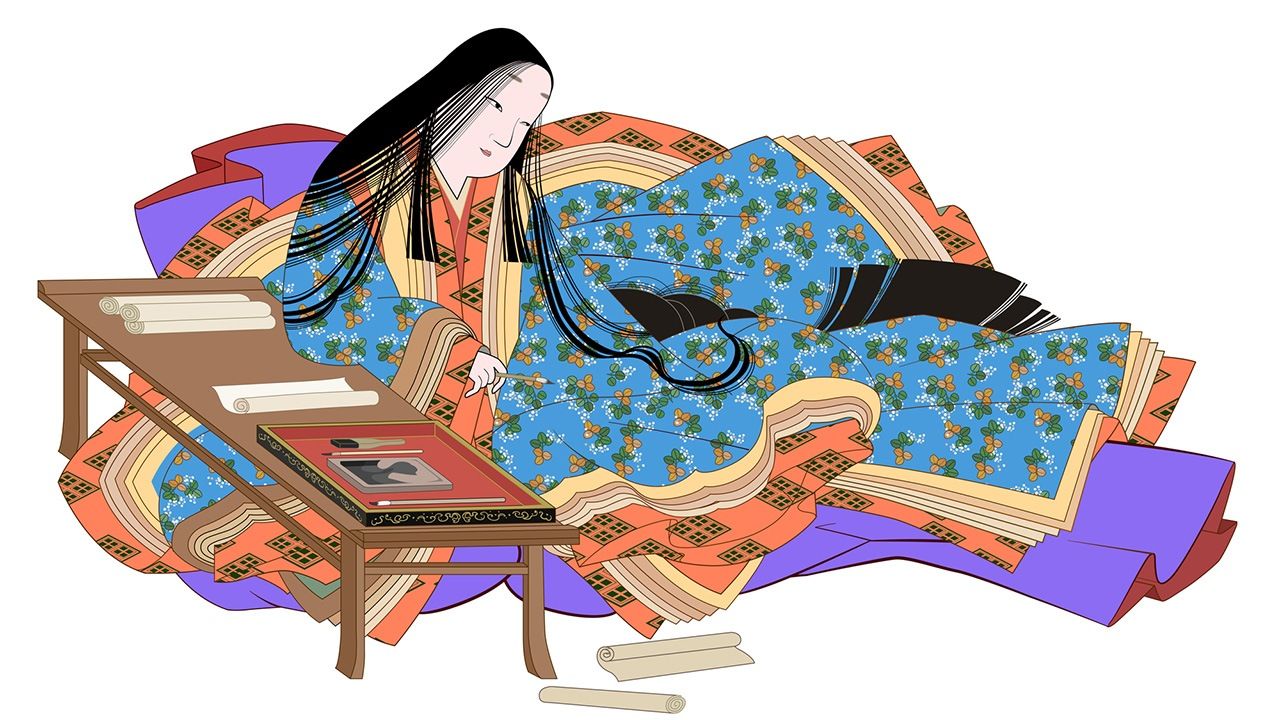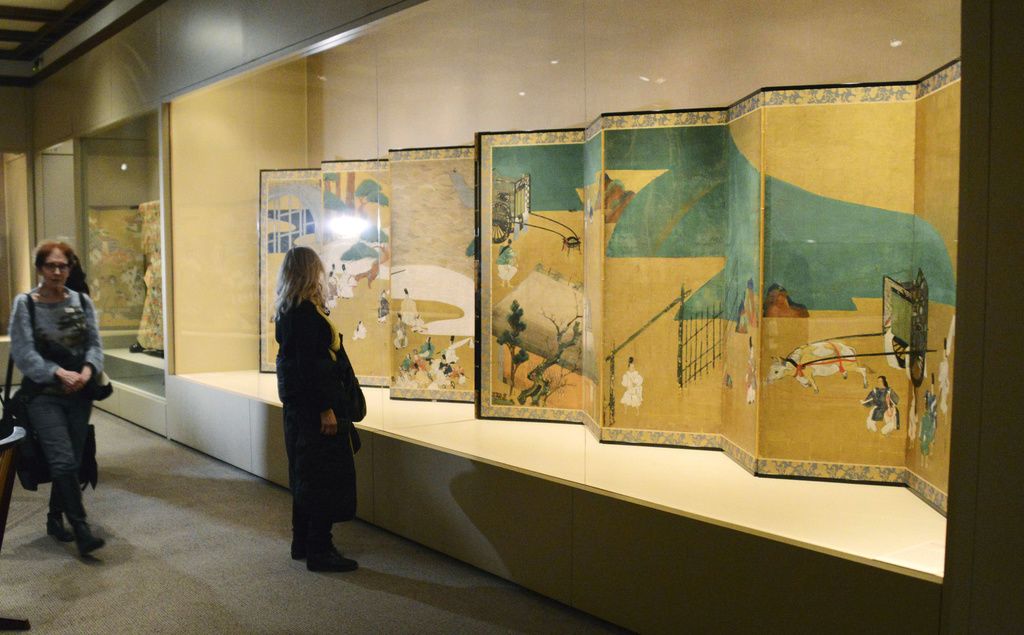
“Murasaki Shikibu and Fujiwara no Michinaga”: Literature and Power in the Heian Court
Books Culture History Society- English
- 日本語
- 简体字
- 繁體字
- Français
- Español
- العربية
- Русский
Daughter of a Poor Scholar
Murasaki Shikibu, the author of The Tale of Genji, and the powerful statesman Fujiwara no Michinaga were contemporaries of the Heian period (794–1185). In fictional contexts, the two are often depicted as being very close or even romantically involved.
Kuramoto Kazuhiro, a professor at the International Research Center for Japanese Studies, seeks to dampen such flights of imagination in his new work on Murasaki and Michinaga. In the introduction, he comments, “What kind of situation is it when stories take on a life of their own, and people get the mistaken impression that Murasaki Shikibu and Michinaga really were just like they appear in dramas?” He aims in his book to state what can actually be ascertained as truth about them from primary sources, such as their diaries. He writes about both figures, but I want to focus here on introducing Murasaki.
Murasaki’s parents were born in the northern Fujiwara clan, and as such, were part of the aristocracy, although Kuramoto notes that her father Tametoki hailed from a minor branch and was nothing more than a “poor scholar without an official position.” Incidentally, we do not know Murasaki’s real name as “Murasaki Shikibu” was bestowed on her by later writers for the sake of convenience. There are also conflicting theories as to when she was born, but Kuramoto argues that it was in 973.
Her mother died early and Tametoki remarried. Later, her father became a regional governor, but this was after a long time without any position. Murasaki had a yearning to acquire knowledge from a young age. She was instructed in the Chinese classics by her father. She also became well versed in Buddhist works, Japanese poetry, and other writings, and grew to be an accomplished writer of waka verse, a talent that opened the path to court society.
A Brief Marriage
In 998, Murasaki married Fujiwara no Nobutaka, a capable but older official who was in his late forties. Nobutaka already had children with three other women and is described by Kuramoto as “dissipated.” The marriage for Murasaki, who was in her mid-twenties, was late by the standards of the day. At the time, it was customary for men to enter the woman’s household upon marriage. However, her father’s lack of position when she was younger strained finances, making it impossible for Murasaki to find a husband until she was older.
Kuramoto says that after their marriage, “Nobutaka didn’t live with Murasaki, but instead stayed with one of his other wives.” The next year Nobutaka wrote poetry describing lovers’ quarrels, something Kuramoto points to as showing Murasaki’s strength of character. The couple had a daughter, but after just two and a half years of wedded life, Nobutaka died of illness.
Although the union was brief, the days Murasaki spent with Nobutaka must have shaped her singular views on men and marriage. Ultimately, she expressed these in many ways in the world of The Tale of Genji.
Imperial Power and Palace Politics
Widowed, Murasaki entered service with Michinaga’s daughter Empress Shōshi. Michinaga had maneuvered to install his daughter as the wife of Emperor Ichijō, but she was not the favorite of the ruler, who preferred to dote on his first consort Teishi.

Screens by Tawaraya Sōtatsu illustrating scenes from The Tale of Genji, on display at the Metropolitan Museum of Art in New York in 2019. (© Kyōdō)
Stretching to 54 chapters, The Tale of Genji is an immensely long work. According to Kuramoto, Murasaki began writing it after her husband’s death, but before she started court service. As a widow, continuing to work on it when her duties allowed, it must have been difficult to get hold of materials, as paper was a valuable commodity at the time. How was she able to complete her masterpiece? According to her diary, Michinaga provided paper, brushes, ink, and inkstones. But why did he do so?
The Tale of Genji, written based on Murasaki’s experiences in the inner palace, played a part in Michinaga’s scheming to achieve absolute power. Kuramoto’s explanation of this process is one of the book’s highlights. He argues that while seemingly an elegant tale of love affairs, Murasaki’s classic work vividly depicts the inner workings of imperial power and palace politics. Emperor Ichijō was a lover of stories and regularly visited Shōshi to listen to the narrative read aloud. Naturally, Michinaga’s aim was to use the work as a way of increasing the emperor’s attachment to his daughter.
After a political tussle with Ichijō’s successor, Emperor Sanjō, Michinaga managed to install his grandson, the son of Ichijō and Shōshi, on the throne as Emperor Go-Ichijō. Michinaga himself became the center of power as the regent, and sometimes he would make use of Murasaki. Palace life did not suit Murasaki, though, and in her later years she became devoted to Pure Land Buddhism; she even wished to renounce the world. Michinaga died in 1027 at the age of 62. Scholars disagree on whether Murasaki died before or after him, but Kuramoto concludes that “the prosperity of Michinaga’s house came to him from Murasaki Shikibu and The Tale of Genji.”
Comparing fictional depictions of Murasaki and Michinaga, such as in this year’s NHK taiga drama, with the actual history is one way to enjoy the pair’s story. Was it even possible that the son of a family of regents would have met the daughter of a poor scholar when they were children? As for the commonly held view that Murasaki was Michinaga’s mistress, Kuramoto dismisses the idea, pointing out that there is scant academic evidence suggesting a romantic connection.
Murasaki Shikibu to Fujiwara no Michinaga
By Kuramoto Kazuhiro
Published by Kōdansha
ISBN: 978-4-06-533254-2
(Originally published in Japanese. Banner photo © Pixta.)
book review books Heian period Murasaki Shikibu Fujiwara no Michinaga
